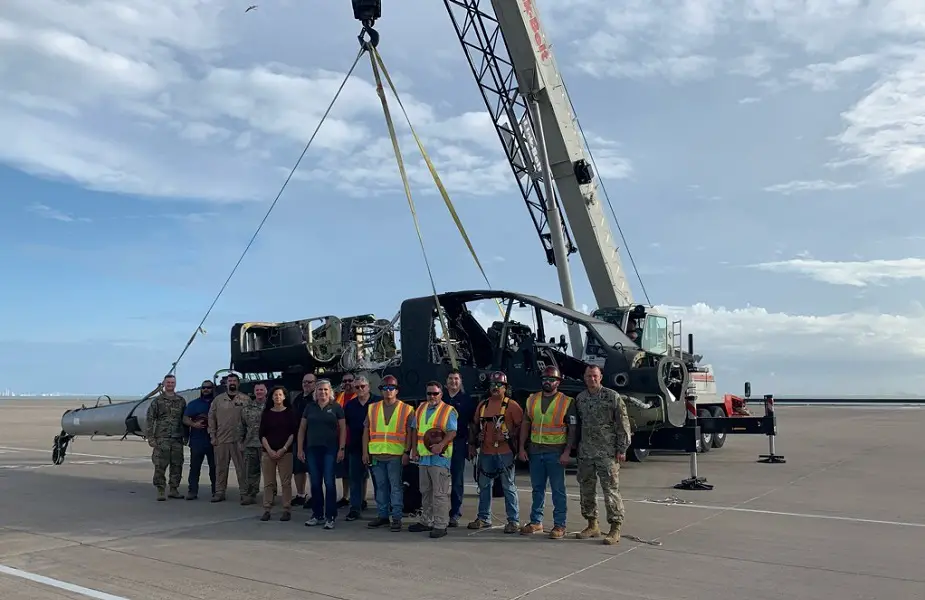Breaking news
US Army Aviation and National Institute for Aviation Research to develop an Apache Digital Twin.
The U.S. Army Aviation enterprise is collaborating with Wichita State University’s National Institute for Aviation Research to develop an Apache Digital Twin in a contract that kicked off with an event on July 29, 2022.
Follow Air Recognition on Google News at this link

The U.S. Army and Wichita State University’s National Institute for Aviation Research are partnering to create an Apache Digital Twin, which takes apart an existing helicopter to scan each part to create 3D models (Picture source: U.S. Army / Aviation and Missile Command)
The Apache Digital Twin program follows the Black Hawk Digital Twin, which took an existing helicopter apart and scanned each part to create 3D models. It’s a laborious process. but one that is necessary to continue moving the aviation enterprise from its current 2D, document-driven engineering practices to the use of modern 3D digital engineering practices, to supporting the transition to Future Vertical Lift’s entirely digital design, and to sustaining the enduring fleet.
“We have to speed up the Army’s transition to 3D digital engineering practices,” said Maj. Gen. Walter “Wally” Rugen, director for the Future Vertical Lift Cross-Functional Team. “The aviation enterprise needs to start now establishing the processes, tools and training methods required to transition and cultivate a relevant workforce from the industrial age to the digital era.”
The Black Hawk and Apache digital twin programs will help:
- Provide the military with models and methods to increase the robustness of the supply base
- Create digital work instructions
- Train new engineers and maintainers in a virtual environment
- Create a pathway for exposure and training in digital engineering principles
Advanced sustainment practices leveraging innovative digital engineering will provide maintenance personnel the ability to identify, diagnose and repair faults more accurately and in less time thereby improving overall readiness of the operational fleet and significantly reduce operating and sustainment costs.
The virtual prototyping program drives new technologies into the enduring fleet while building the foundation for the future fleet. The Future Long Range Assault Aircraft, Future Attack Reconnaissance Aircraft and Future Tactical Unmanned Aircraft System programs view the virtual prototypes as a step toward eventual use of a digital twin and plan to incorporate its use as is feasible throughout the programs.
The open-systems architecture that the Army is developing for the future helicopters should be the primary driver of lower sustainment costs for the new aircraft. All three programs embrace the use of digital modeling and simulation. It’s one method to assist in rapid prototyping, while reducing testing timelines, acquisition risk and sustainment costs.
“We work as a team inside [Program Executive Office] Aviation,” said Brig. Gen. Robert “Rob” Barrie, Program Executive Officer for Aviation. “We do it with industry, we do it with my colleagues [in the Army Aviation enterprise], but more importantly we do it with the entirety of our nation. What I see here at Wichita State certainly inspires me for our future, [and I understand and value] the importance of the work you’re doing here.”
Allowing the Army to manufacture parts and replacements that are hard to get or too costly for vendors to make will continue to reduce operational and sustainment costs for the enduring fleet models.
“Creating a digital twin of an AH64 will help us transition our data systems to take advantage of 3D architectural drawings, which are being used for all of our signature modernization efforts,” said Maj. Gen. Todd Royar, commanding general for Aviation and Missile Command. “It will also enable readiness for the Apache fleet by being able to produce parts faster.”
The U.S. Army is modernizing Army Aviation with transformational speed, range and lethality. The digital twin effort is an example of Army Futures Command’s unique approach to developing requirements through establishing partnerships with multiple organizations across the Army, industry, and academia.
The Future Vertical Lift Cross Functional Team, Aviation Program Executive Office, Aviation and Missile Center, and Aviation and Missile Command joined together to partner with Wichita State University to produce digital twins of current fleet helicopters. The role of the enduring fleet will continue to be an integral part of the future battlefield, and sustainment and modernization of that fleet remains a priority.

























